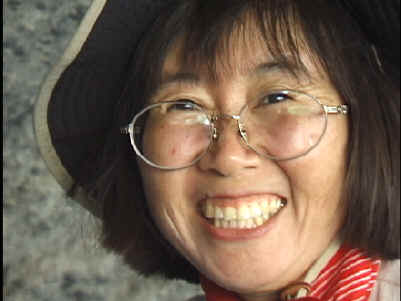An
Interview with Harumi Fujita
on the Archaeology of Baja California Sur, and possibly one of the oldest sites in the
Americas

An
Interview with Harumi Fujita
|
 |
| 1. Can you tell us something about your
background? I was born in Otaru, a port near Sapporo in northern Japan. I lived in Sapporo until I was 5 years old and then went to Ann Arbor, Michigan, with my mother and my brother to join my father who was doing medical research in the University of Michigan. I went to primary school in Ann Arbor for two years and went back to Sapporo and lived there until I graduated from the University of Hokkaido. Then I went to Israel to stay in two kibbutzes as a volunteer and a Hebrew student for almost two years. On weekends I visited various archaeological ruins and I decided that I wanted to study archaeology in Mexico after I received information from my Mexican colleagues in Hebrew class. I studied archaeology in the ENAH (Escuela Nacional de Antropologia e Historia) in Mexico City from 1978 to 1982 and during my studies I met Jesus Mora and Baudelina Garcia Uranga who kindly invited me to their project in Baja California. I really enjoyed the field seasons and was impressed by the natural setting and the archaeological sites there. Altogether, I participated in four field seasons, and I wrote my thesis about shellfish gathering among prehistoric Baja California Indians. In 1985 I obtained a B.A. in Archaeology., and in 1991 I was appointed a researcher for INAH in BCS. 2. Can you tell us something about archaeology in Baja California Sur? Baja California Sur is a large state and I am in charge of the Cape Region. From 1991 I started my project to identify and record the sites and up until now, I have recorded 450 sites. Since I was doing survey mostly along the coast, shell middens are the most abundant site type. Habitational cave sites, open habitational sites, funeral caves, lithic quarries, painting sites, and non-habitational open sites are the rest of site types. I was also in charge of various salvage and rescue works. From 2001 I have been in charge of another project called, "Peopling of America seen from the Espíritu Santo Island". In Babisuri rock shelter on this island, we can identify human evidence from the Pleistocene era to European contact period. Espíritu Santo Island 3. How did you discover the Babisuri site, and what were your first impressions of it? As a part of my project to identify and record the sites, in 1994 we did a systematic survey from the southern tip to the central western part of Espíritu Santo island, recording 66 sites. One of the rock shelter sites was Babisuri rock shelter. In 1996 we continued recording the sites on the rest of the island, recording 61 sites. I also excavated test pits in 5 sites to obtain shell samples for radiocarbon dating to estimate the chronology of these sites. Babisuri rock shelter was one of the five. In 2000, I received the results and we were surprised to learn the dates from the lower levels. Three shell samples were dated between 36,000 and 42,000 b.p. Babasuri Rock Shelter In 2001, a larger project was carried out and we excavated 7 meters x 1 meter down to bed rock, which was between 80 cm and 1m 40 cm deep. We found numerous shellfish remains and lithics, some land and marine fauna remains, seeds, wood remains and some shell ornaments and tools. A burial was found associated with numerous metal objects. Until now we cannot confirm the age of the first human occupation, but it is older than 10,000 years ago. After 10,000 years, the site was occupied continuously until European contact. We have not found other significant evidence for radiocarbon dating, such as bones or charcoal for the earliest stage, but we are expecting to find them in the next field work seasons. We did extensive excavation in 2003-2004, 35-40 cm deep, corresponding to approximately 3000-4000 years b.p. We found remains and artifacts similar to those found in the former excavations. In addition, a well-formed hearth, some shell arrangements (maybe with religious meanings), a fluted pearl, and various pearl oyster ornaments were found. As I mentioned before, a burial (adult male) was found in a flexed position associated with numerous metal objects and Comondú-type projectile points. The AMS radiocarbon dating for these human remains is 800 years b.p. (1180 and 1280 A.D.) This means that this Indian was buried before the official discovery of Baja California by the Spaniards. I am investigating the origin of the metals. |